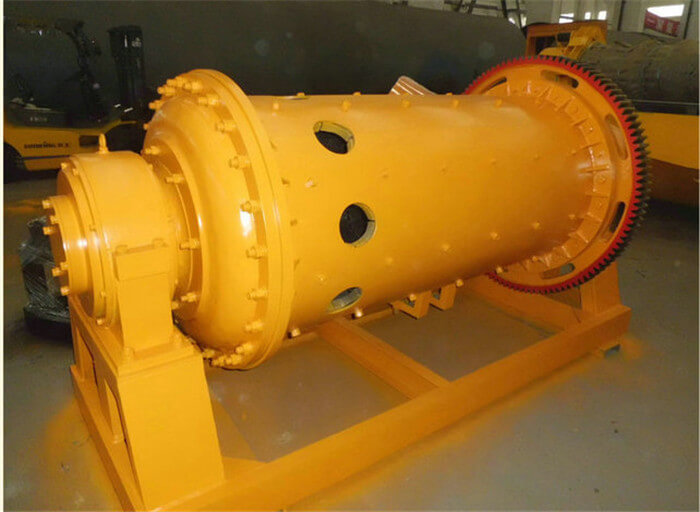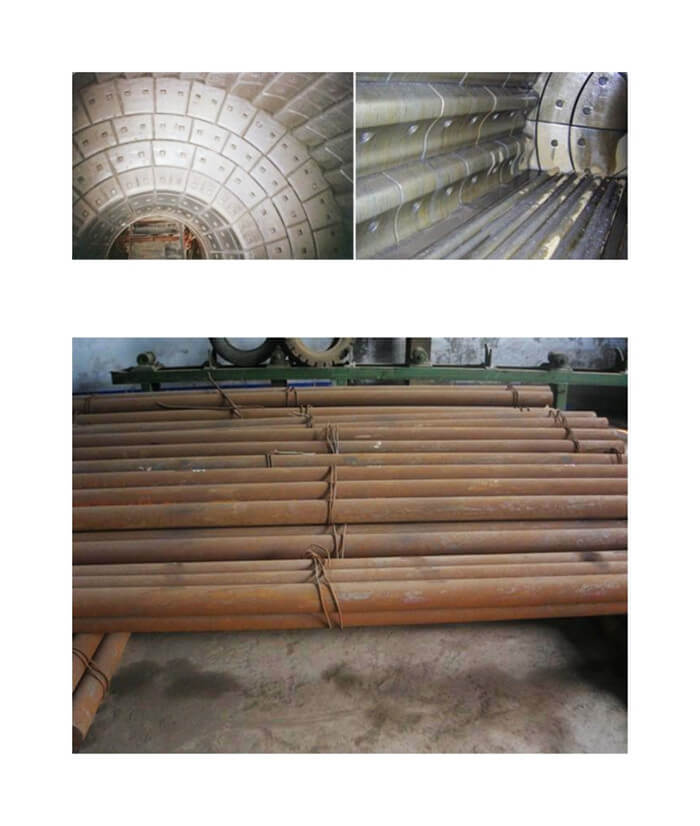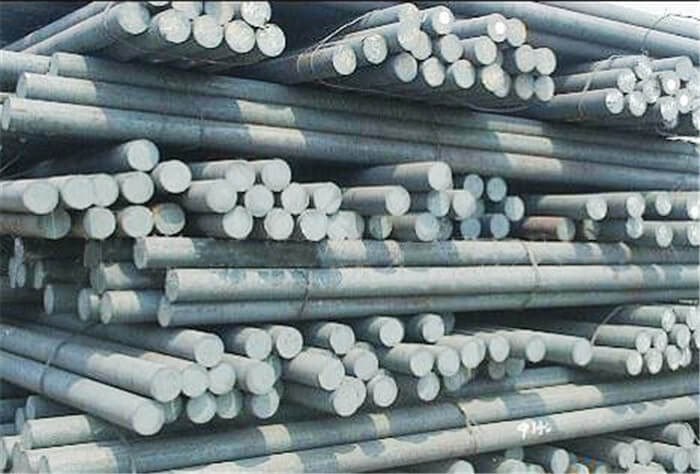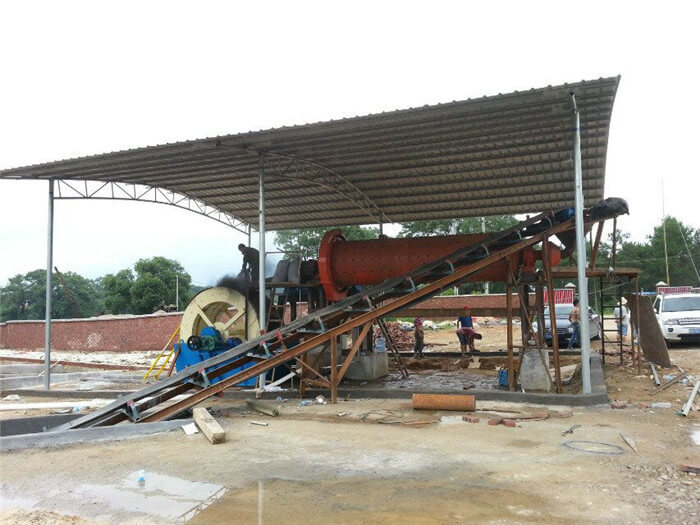
Introduction:
Rod mill is widely applied in metal and nonmetal mine, water conservancy, glass and construction materials industries, mainly suitable for grinding various ores and rocks and artificial sand-making. Our high-efficiency rod mill adopts rolling bearing support instead of sliding bearing support with bearing bush. Therefore, it has advantages of even discharging size and high capacity.
A rod mill is an ore grinding mechanism that uses a number of loose steel rods within a rotating drum to provide its attrition or grinding action. An ore charge is added to the drum, and as it rotates, friction between the tumbling rods breaks the ore down into finer particles. Although similar in operation, a rod mill is often more effective than a ball mill as it requires lower rotational speeds and less steel to achieve the same results. It is, however, limited to maximum rod and drum lengths of approximately 20 feet (6 meters) and is generally only used for wet grinding processes. The rod mill also tends to suffer from accelerated drum liner and lifter wear due to the increased weight of the rods.
The rod mill can be widely used for grinding artificial sand in ore dressing plant, chemical plant and the electricity sector. Rod mill rotates surrounding gear reducer when driven by the motor. The appropriate grinding tool-steel bar is installed inside the cylinder body. The grinding tool, under centrifugal force and friction force, will be promoted to a certain height and then fell down. Finished products will be discharged from the discharging part.

Working Principle of Rod Mill
The rod mill drives the cylinder in rotation by the engine through the rotation of the reducer and big gears around with the deceleration or through low speed synchronous motor driving directly peripheral big gears. The machine is equipped with appropriate grinding medium-steel bar, which is raised to a certain height under the centrifugal force and friction force and then cast down or discharged. The materials to be crushed are continuously added to the cylinder, shattered by the rotating grinding medium and discharged for the next procedure by the overflow and the power produced by continuously feeding in materials.
Rod mill works by relying on the moderative motion of peripheral rack wheel through electrical machine and reducer or the bradytelic synchronous electrical machine. There is proper ore grinding medium inside the barrel, namely steel bar. Under the functions of centrifugal force and frictional force, ore grinding medium is raised to a certain height and then falls in drop or draining falling state. The ground material is fed into the barrel from the feeding port and crushed by the moving grinding medium. At last, the final materials are discharged to the next procedure under the overflow and continuous feeding force.
A rod mill is an ore grinding mechanism that uses a number of loose steel rods within a rotating drum to provide its attrition or grinding action. An ore charge is added to the drum, and as it rotates, friction between the tumbling rods breaks the ore down into finer particles. Although similar in operation, a rod mill is often more effective than a ball mill as it requires lower rotational speeds and less steel to achieve the same results. It is, however, limited to maximum rod and drum lengths of approximately 20 feet (6 meters) and is generally only used for wet grinding processes. The rod mill also tends to suffer from accelerated drum liner and lifter wear due to the increased weight of the rods.

Structural characteristics
The structure of the rod mill is roughly as same as the ball mill, but there are three differences:
(1) Rod mill commonly uses steel bars with diameter of 50-100mm as the grinding tool, while ball mill uses steel balls as grinding tool. The length of steel bar is 25-50mm shorter than the tube, and often made up of high-carbon steel with carbon content of 0.8% -1%; the rod load is approximately 35% -45% of the effective volume of the rod mill. Seen with the naked eyes, the horizontal plane of the rod is about 100-200mm below the cylinder centerline.
(2) For rod mill, the diameter is generally 1.5-2.0m, and the end cap on the liner surfaces shall be the vertical plane, the purpose of which is to prevent and reduce the steel bar from producing chaotic movement in the cylinder body, and ensure the regularity of exercise of steel bars. For ball mill, the cylinder length and diameter are smaller.
(3) The rod mill usually uses the overflow type instead of the grid plate to discharge ore materials; generally, the diameter of row material shall be larger than that of ball mill; and the rotating speed of the rod mill cylinder is less than the speed of ball mill.
|
Model |
Cylinder size (D×L) (mm) |
Effective volume (m³) |
Balls weight(t) |
Rotating speed(r/min) |
Power(kw) |
Discharge size(mm) |
Capacity(t/h) |
Weight(t) |
|
MB0918 |
900×1800 |
0.85 |
2.3 |
38 |
22 |
2.5-0.2 |
6-1.6 |
6.2 |
|
MB0924 |
900×2400 |
1.15 |
3.1 |
38 |
30 |
2.5-0.2 |
10-2.9 |
6.6 |
|
MB1224 |
1200×2400 |
2.2 |
6.5 |
32 |
55 |
2.5-0.2 |
13-5 |
13.5 |
|
MB1530 |
1500×3000 |
5.0 |
8 |
27 |
75 |
2.5-0.2 |
12-5.5 |
16.7 |
|
MB1830 |
1800×3000 |
6.5 |
17 |
22.8 |
132 |
2.5-0.2 |
20-9.5 |
29.8 |
|
MB2122 |
2100×2200 |
6.7 |
18 |
20.9 |
160 |
2.5-0.2 |
27-12 |
42.5 |
|
MB2130 |
2100×3000 |
9.2 |
25 |
20.9 |
160 |
2.5-0.2 |
30-13 |
43.9 |
|
MBZ2136 |
2100×3600 |
11.0 |
28 |
20.9 |
200 |
2.5-0.2 |
35-14.8 |
49.4 |
|
MB2140 |
2100×3600 |
11.0 |
32.5 |
20.9 |
210 |
2.5-0.2 |
61.5-43 |
49.9 |
|
MB2145 |
2100×4000 |
12.2 |
31 |
20.9 |
220 |
2.5-0.2 |
38-17 |
50.3 |
|
MBZ2430 |
2100×4500 |
13.8 |
35 |
20.9 |
250 |
2.5-0.2 |
43-19 |
51.8 |
|
MB2430 |
2400×3000 |
12.2 |
31 |
19 |
250 |
2.5-0.2 |
47-22 |
56.0 |
|
MB2430 |
2400×3000 |
12.2 |
31 |
19 |
250 |
2.5-0.2 |
73-52 |
58.3 |
|
MB2436 |
2400×3600 |
14.6 |
37 |
19 |
280 |
2.5-0.2 |
55-26 |
61.0 |
|
MB2436 |
2400×3600 |
14.6 |
37 |
19 |
280 |
2.5-0.2 |
84-60 |
62.4 |
|
MB2730 |
2700×3000 |
15.3 |
35 |
17.5 |
315 |
5-0.8 |
125-37.5 |
75.6 |
|
MB2736 |
2700×3600 |
18.4 |
42 |
17.5 |
355 |
5-0.8 |
150-45 |
81.8 |
|
MB2740 |
2700×4000 |
20.5 |
47 |
17.5 |
400 |
5-0.8 |
165-50 |
84.3 |
|
MB3040 |
3000×4000 |
25.9 |
50 |
16.2 |
500 |
5-0.8 |
206-62 |
130 |
|
MB3245 |
3200×4500 |
33 |
56 |
15.5 |
630 |
5-0.8 |
228-70 |
138 |
|
MB3248 |
3200×4800 |
34 |
60 |
15.5 |
710 |
5-0.8 |
240-74 |
142 |
|
MB3645 |
3600×4500 |
40.8 |
78 |
14.5 |
800 |
5-0.8 |
270-83 |
168 |
|
MB3654 |
3600×5400 |
50 |
94 |
14.5 |
1000 |
5-0.8 |
340-103 |
192 |












